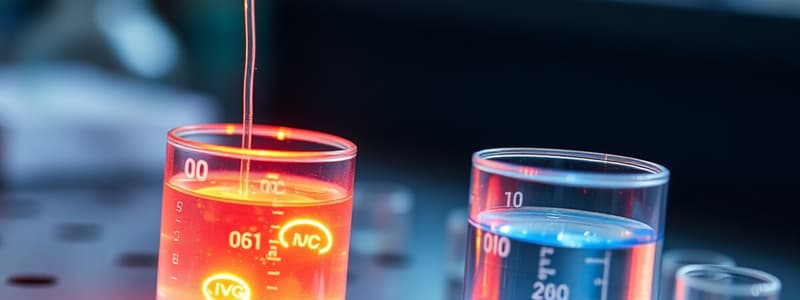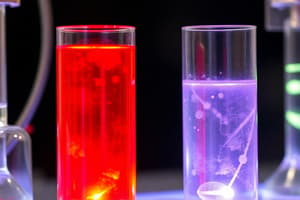Podcast
Questions and Answers
In an electrochemical cell, which of the following statements accurately describes the movement of electrons?
In an electrochemical cell, which of the following statements accurately describes the movement of electrons?
- Electrons flow from the cathode to the anode through the external circuit.
- Electrons flow from the anode to the cathode through the salt bridge.
- Electrons flow from the cathode to the anode through the electrolyte solution.
- Electrons flow from the anode to the cathode through the external circuit. (correct)
Which of the following is always true for a spontaneous redox reaction in an electrochemical cell under standard conditions?
Which of the following is always true for a spontaneous redox reaction in an electrochemical cell under standard conditions?
- The standard cell potential (\$E^\circ_{cell}\$) is equal to zero.
- The standard cell potential (\$E^\circ_{cell}\$) is negative.
- The standard free energy change (\$\Delta G^\circ\$) is positive.
- The standard cell potential (\$E^\circ_{cell}\$) is positive. (correct)
What is the primary function of a salt bridge in a galvanic cell?
What is the primary function of a salt bridge in a galvanic cell?
- To prevent the oxidation and reduction reactions from occurring.
- To maintain electrical neutrality in the half-cells by allowing ion flow. (correct)
- To facilitate the flow of electrons between the two half-cells.
- To provide a direct electrical connection between the anode and the cathode.
Consider an electrolytic cell used for the electrolysis of molten NaCl. Which of the following statements is correct regarding the reactions at the electrodes?
Consider an electrolytic cell used for the electrolysis of molten NaCl. Which of the following statements is correct regarding the reactions at the electrodes?
Using the Nernst equation, how does increasing the concentration of reactants in a galvanic cell generally affect the cell potential (Ecell)?
Using the Nernst equation, how does increasing the concentration of reactants in a galvanic cell generally affect the cell potential (Ecell)?
In the context of corrosion, what is the purpose of using a sacrificial anode?
In the context of corrosion, what is the purpose of using a sacrificial anode?
Which of the following statements correctly describes the relationship between oxidation, reduction, and the terms 'reducing agent' and 'oxidizing agent'?
Which of the following statements correctly describes the relationship between oxidation, reduction, and the terms 'reducing agent' and 'oxidizing agent'?
If the standard reduction potential (Ered) of $Cu^{2+}/Cu$ is +0.34 V and that of $Zn^{2+}/Zn$ is -0.76 V, what is the standard cell potential (Ecell) for a galvanic cell using these two half-cells?
If the standard reduction potential (Ered) of $Cu^{2+}/Cu$ is +0.34 V and that of $Zn^{2+}/Zn$ is -0.76 V, what is the standard cell potential (Ecell) for a galvanic cell using these two half-cells?
During the electrolysis of water, what volume ratio of hydrogen to oxygen gas is produced?
During the electrolysis of water, what volume ratio of hydrogen to oxygen gas is produced?
A battery is designed using a specific electrochemical reaction. Over time, the battery loses its ability to provide the same level of current. Which of the following is the most likely reason for this decrease in performance?
A battery is designed using a specific electrochemical reaction. Over time, the battery loses its ability to provide the same level of current. Which of the following is the most likely reason for this decrease in performance?
Flashcards
Electrochemistry
Electrochemistry
The study of chemical processes causing electron movement, creating or using electricity.
Redox Reactions
Redox Reactions
Reactions involving the transfer of electrons between chemical species.
Oxidation
Oxidation
Loss of electrons by a molecule, atom, or ion.
Reduction
Reduction
Signup and view all the flashcards
Electrochemical Cell
Electrochemical Cell
Signup and view all the flashcards
Anode
Anode
Signup and view all the flashcards
Cathode
Cathode
Signup and view all the flashcards
Cell Potential (Ecell)
Cell Potential (Ecell)
Signup and view all the flashcards
Standard Reduction Potential (E°red)
Standard Reduction Potential (E°red)
Signup and view all the flashcards
Nernst Equation
Nernst Equation
Signup and view all the flashcards
Study Notes
- Electrochemistry is the study of chemical processes causing electron movement
- Electron movement generates electricity for powering devices or drives non-spontaneous chemical reactions when electricity is applied.
- Electrochemical reactions are redox reactions involving electron transfer.
- Oxidation is the loss of electrons while reduction is the gain of electrons; both always occur together
- The substance oxidized is the reducing agent; the substance reduced is the oxidizing agent.
- Electrochemical cells convert chemical energy to electrical energy and vice versa
- Galvanic cells (voltaic cells) convert chemical energy into electrical energy.
- Electrolytic cells convert electrical energy into chemical energy.
- A galvanic cell contains two half-cells, each with an electrode in electrolyte solution
- The half-cells connect via a salt bridge, allowing ion flow to maintain charge balance.
- Oxidation occurs at the anode
- Reduction happens at the cathode
- Electrons flow from anode to cathode via an external circuit
- Electron flow creates electric current.
- Cell potential (Ecell) is the electrical potential difference between cathode and anode.
- Cell potential measures the electrochemical reaction's driving force and is also known as electromotive force (EMF)
- Standard cell potential (E°cell) is the cell potential when reactants and products are in standard states (1 M for solutions, 1 atm for gases, pure solids/liquids).
- Standard reduction potential (E°red) refers to a half-cell's potential under standard conditions, relative to the standard hydrogen electrode (SHE)
- The SHE has a standard reduction potential of 0 V
- Cell potential is calculated as: E°cell = E°cathode - E°anode.
- A positive cell potential means the reaction is spontaneous under standard conditions; a negative potential means it's non-spontaneous
- The Nernst equation relates cell potential to standard cell potential and the reaction quotient (Q): Ecell = E°cell - (RT/nF) ln Q
- R is the ideal gas constant (8.314 J/mol·K).
- T is temperature in Kelvin.
- n is the number of moles of electrons transferred in the balanced redox reaction.
- F is the Faraday constant (96,485 C/mol).
- The reaction quotient (Q) measures relative amounts of reactants and products at a given time
- Electrolytic cells use electrical energy to drive non-spontaneous reactions.
- Electrolysis uses electrical energy to decompose a compound.
- Electrolysis has uses in industrial processes such as producing aluminum, chlorine, and sodium hydroxide
- In an electrolytic cell, the anode is positive and the cathode is negative
- Electrons are forced to flow from anode to cathode using an external power source
- The amount of product formed during electrolysis relates to the amount of charge passed through the cell
- Faraday's law: The amount of substance produced or consumed at an electrode is directly proportional to the amount of electricity passed through the cell
- Charge (Q) passed through the cell is calculated as Q = It
- I is current in amperes; t is time in seconds
- The amount of substance (in moles) produced or consumed is calculated as moles = Q/nF
- n is the number of moles of electrons transferred per mole of substance.
- Corrosion is the oxidation of a metal and is an electrochemical process
- Rusting of iron is a common example of corrosion
- Corrosion prevention includes coating metal with a protective layer or using a sacrificial anode
- Sacrificial anode: A metal that is more easily oxidized than the metal it protects
- The sacrificial anode corrodes instead of the metal it is protecting
- Batteries are galvanic cells that store and provide electrical energy
- Different battery types: dry cells, lead-acid batteries, and lithium-ion batteries
- Fuel cells convert chemical energy of a fuel and oxidant into electrical energy
- Fuel cells are similar to batteries but do not need recharging
- Fuel cells operate continuously with fuel and oxidant supply
- The hydrogen fuel cell is the most common, using hydrogen as fuel and oxygen as oxidant.
Studying That Suits You
Use AI to generate personalized quizzes and flashcards to suit your learning preferences.




